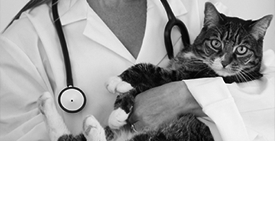Library
-
H1N1 influenza virus emerged in pigs as a genetic sharing of DNA from both human and swine influenza viruses. It caused a deadly pandemic in 2009 and continues to be an important cause of illness today. Pets including cats and dogs can be infected from their owners and become ill. It is not yet known to transfer from pets to humans. Good hygiene and restricted exposure should be taken immediately if there is any sign of influenza-like infection to restrict spread between humans, and between humans and their pets or domestic animals.
-
Tapeworms are parasites that infect the gastrointestinal tract of cats, other animals, and humans. Several types of tapeworms are known to infect pets, but the most common species observed in cats is Dipylidium caninum, which is transmitted through fleas. Risk factors, clinical signs, treatment, and prevention are explained in this handout. Other, less common types of tapeworms that affect cats and humans are also covered.
-
Tetanus is a medical condition caused by a toxin. This toxin, produced by the bacteria Clostridium tetani, affects the nerves, spinal cord, and brain, leading to hyperexcitability resulting in muscle spasms. Cats are less susceptible to the effects of tetanus toxin than humans and horses. Tetanus is typically diagnosed based on exam findings. Cats with tetanus require intensive nursing care. Most cats develop localized, self-limiting disease, which will respond to appropriate early treatment.
-
Toxoplasma occurs worldwide. However, infection is uncommon in pet cats that do little or no hunting and primarily or exclusively eat commercial cat foods. Despite the high number of cats infected with T. gondii, very few show significant clinical signs. Humans are most commonly infected by eating contaminated food. Most people infected with this organism do not develop clinical disease. However, infection during pregnancy may be transmitted to the fetus and sometimes cause severe damage. Many pet cats will never be exposed to Toxoplasma and, therefore, cannot pass the infection on to humans.
-
Trifluridine is an antiviral topical medication used to treat viral infections of the eye, such as herpesvirus-1 in cats. Give as directed. Side effects include eye irritation. Do not use in pets with an allergy to this medication. If a negative reaction occurs, please call the veterinary office.
-
Tularemia is an infection of the bacteria Francisella tularensis and is most common in rabbits and rodents. Infection in cats occurs from ingestion of an infected animal, drinking contaminated water, or getting bitten by a blood-sucking insect. Clinical signs include enlarged lymph nodes and draining abscesses. Treatment includes antibiotics, surgical removal of any draining abscesses, and any other supportive care warranted by the cat's condition. Tularemia is a reportable zoonotic disease.
-
Uveitis is an inflammation of one or more of the structures making up the uvea (part of the eye). Signs of uveitis are severe pain with an intense reddening of the visible parts of the eye. Measurement of intraocular pressure is often performed to diagnose uveitis. Treatment involves reducing the pain and inflammation in the eye as well as treating the initial cause of the disease.
-
There are five primary reasons for vaccination failure. Vaccine inactivation is one reason and is most commonly caused by warming during shipping and handling. In addition, vaccines are not always 100% effective. Cats may also be unhealthy or too young, leading to vaccine failure. Interference by maternal antibodies can lead to the vaccine being blocked. Lastly, cats receiving overwhelming exposure to a virus may have a failure in the effectiveness of the vaccine.
-
Vaccines are necessary to reduce infectious disease-caused illnesses in cats. They work by stimulating the body's immune system to recognize and fight a particular microorganism such as a virus, bacteria, or other infectious organism. The vaccine helps the body prevent infection or lessen the severity of the infection, and promotes rapid recovery.
-
Regular preventive health care for your cat can increase the length and quality of her life. Healthcare guidelines are established and kept up to date using the most recent evidence-based recommendations including the recommendation that all cats receive a complete veterinary examination at least once a year or more frequently, depending on their individual needs and health concerns.


